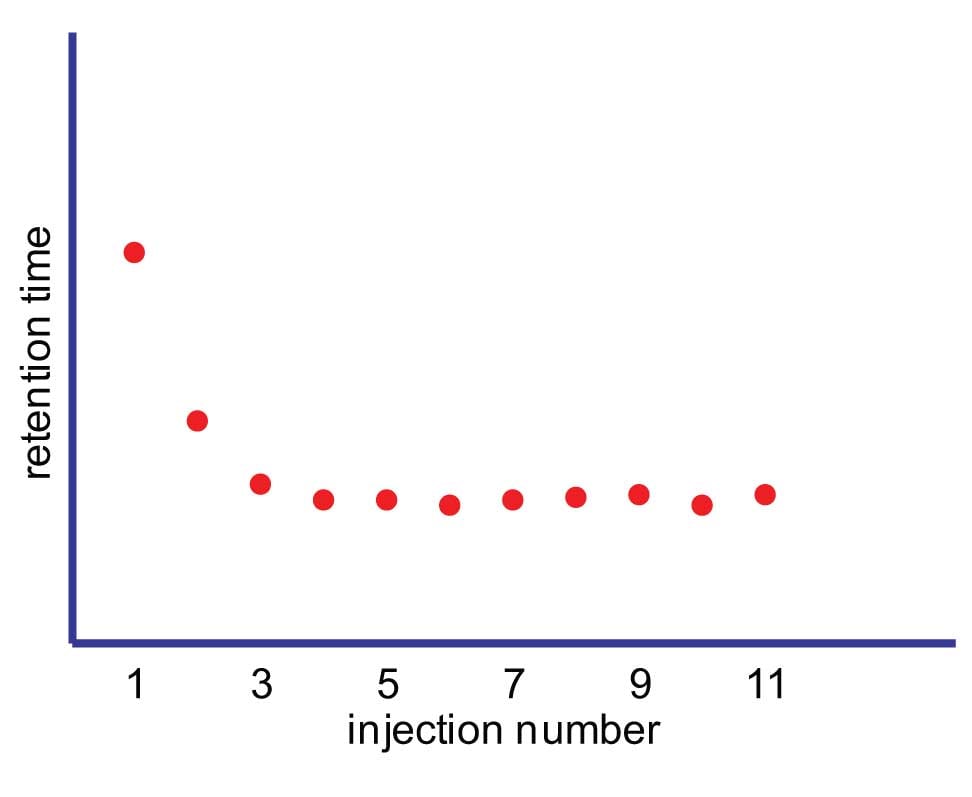How many of you have experienced this? You think you’ve fully equilibrated the HPLC column by running mobile phase through it for 30 min, but for the first 3 or 4 injections, the retention times drift a little, finally settling down after half a dozen injections are made. In some cases, the problem occurs only with a new column, whereas in other methods, each time the method is started, the same pattern of drift is observed.
While I don’t want to characterize this problem as common, it occurs often enough that it is not uncommon, either. Some methods are more prone to this than others. The problem is related to column equilibration, and no, increasing the equilibration before the first injection is not likely to fix the problem. We tend to think of reversed-phase HPLC as a fairly simple process – sample molecules are distributed between a non-polar stationary phase and a more polar mobile phase, with less polar samples having longer retention times. Unfortunately it isn’t quite so simple. Often there is more than one retention mechanism taking place, although reversed-phase, hydrophobic retention dominates in most cases. If a sample molecule is retained by two different mechanisms, the net retention time will be related to the relative population of these two types of active sites. This was a common situation with the older, low-purity, type-A silica columns, where strongly acidic silanol groups were present, acting as cation-exchange sites for ionized bases. These strong interactions were a major cause of peak tailing. With the newer, higher-purity, type-B columns, the population of these acidic silanol groups is greatly reduced, and subsequently tailing is also reduced. One way we used to address the silanol activity was to add a small-molecular-weight base, such as triethylamine (TEA) to the mobile phase. The TEA bound strongly to the acidic silanols and “swamped out” these active sites, greatly reducing tailing.

Well, the same thing can happen in newer columns, though usually to a lesser extent. With the first injection of sample, some of the sample molecules bind strongly to the stronger active sites (e.g., ionized silanols), whereas other sample molecules are retained by hydrophobic retention. As subsequent injections are made, the active sites gradually become blocked, so this retention mechanism becomes less important. As the hydrophobic-to-silanol ratio changes, retention will change. Because there often is a very low population of active silanols on most newer columns, these sites become saturated within the first few injections and retention settles down.
How to avoid the problem? The problem often is hard to eliminate, so the best approach often is to try to accelerate the equilibration process. This is simply done in one of two ways. One is to make several injections in a row, not waiting for the first to be eluted before making the next. This stacks up several samples on the column and shortens the equilibration process. Another approach is to inject one or two high-concentration samples to accomplish the same thing. This is one reason why I always recommend ignoring the first injection when the HPLC system is started – even when intentional loading of the column is not necessary, rarely does the first injection interact with the column in exactly the same way as the second and subsequent injections.
This blog article series is produced in collaboration with John Dolan, best known as one of the world’s foremost HPLC troubleshooting authorities. He is also known for his ongoing research with Lloyd Snyder, resulting in more than 100 technical publications and three books. If you have any questions about this article send them to TechTips@sepscience.com




